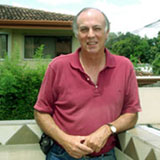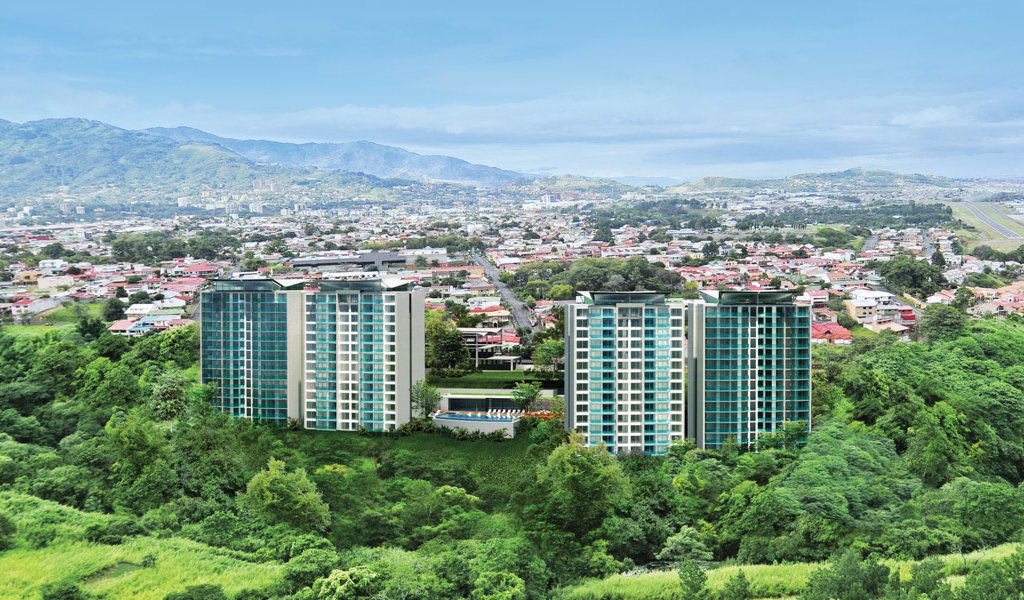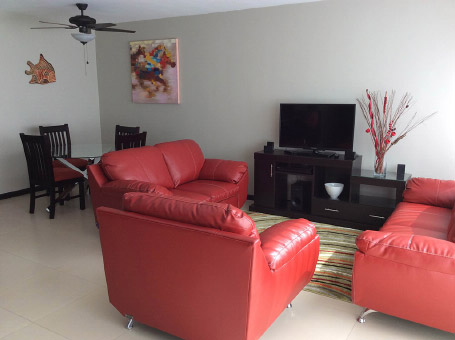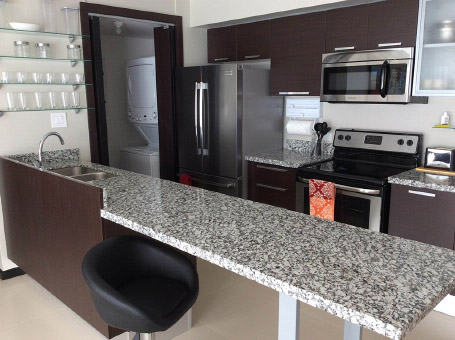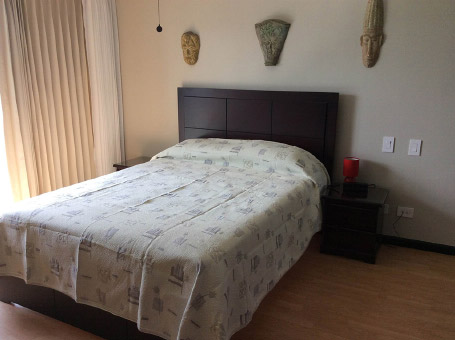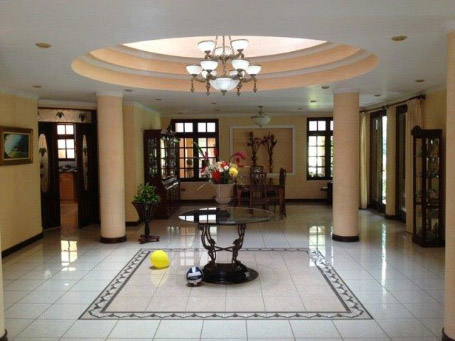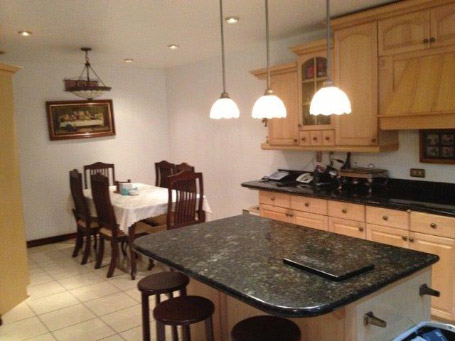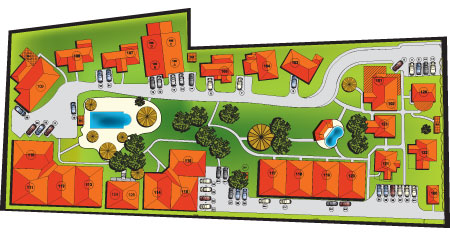1. Multiple eruptions give some residents a taste of the future
By the A.M. Costa Rica staff
“The ash is in my hair and on my clothes!”
That was a typical refrain from residents north of San José Monday as multiple eruptions of the Turrialba volcano sent vapor and ash to the west.
The eruptions grounded aircraft and sent dark clouds sweeping into the foothills to the north.
The bad news is that such eruptions of vapor and ash might continue for some time, perhaps even years, according to the experts.
The hardest hit are those with respiratory weaknesses.
The U.S. Geological Survey said that ash fall was substantial within three kilometers of the volcano crater. Within 10 miles to the southwest there were minor ash falls. Still, the column of ash rose as much as 4.5 kilometers into the air and traces fell as far as the Pacific coast.
The Ministerio de Salud released a list of preventative measures, particularly for those with existing health problems. They included using glasses and a wet handkerchief or mask to protect the face. Also suggested was to rinse the mouth with clean water regularly and to avoid eating in public so as not to accidentally consume ash.
The ministry also noted that ash is slippery, and those who run should take extra precautions and that clothing should be changed if contaminated with ash.
Although local television made a big deal about the eruptions that took place Monday, a check of news files covering the 1963 eruptions of the adjacent Irazú volcano showed that residents in the capital were shoveling ash off the roofs of their homes to prevent collapse.
The Red Sismológica Nacional said that significant eruptions took place at 2:33 a.m., 11:32 a.m., 2:37 p.m, 3:34 p.m. and 4:06 p.m.
The column of ash reached 14,235 feet, said the Observatorio Vulcanológico y Sismológico de Costa Rica. Both agencies follow the volcanoes closely, and the Red had scientists on the summit of Turrialba Monday to adjust the surveillance cameras there.
The Dirección General de Aviación Civil closed Juan Santamaría airport at midday due to the ash falling there. Eight planes were preparing to take off at that time. Only one aircraft managed to land there Monday night, a summary of flight operations showed. More than a dozen incoming flights were either canceled or diverted. Many tourists spent an unexpected night here with the hopes that conditions would be better today.
Daniel Oduber airport in Liberia seemed to be operating normally, but flights to San José were delayed.
During the peak of the ash fall some motorists felt the need to turn on their headlights.
Vehicles are a whole different story, and owners of those in areas with plenty of ash have been advised to have vehicle filters checked.
30 years since secret Contra airstrip discovered in Costa Rica
When the press brought it to light in September 1986, a mile-long secret runway built on a lonely tongue of land jutting into the Pacific Ocean just south of the Nicaraguan border became a major embarrassment for both U.S. and Costa Rican governments. It offered dramatic proof that the administration of U.S. President Ronald Reagan had been using Costa Rica to supply the Nicaraguan Contra rebels, running roughshod over both U.S. and Costa Rican law.
The airstrip came to be a headache for the governments of both countries — an embarrassing symbol of official wrongdoing as well as an “investment dispute” after Costa Rica President Óscar Arias decided to expropriate the land on which it had been built to integrate it into Santa Rosa National Park.
In 1986, Central America was a Cold-War cauldron. Costa Rica found itself in the middle of the war between Nicaragua’s Sandinista government and the U.S.-backed Contras.
Though Luis Alberto Monge, Costa Rica’s president from 1982 to 1986, had declared his country neutral in the conflict, he was under extraordinary pressure from the Reagan administration to allow Costa Rica to be used by the Contras to attack the Sandinistas.
While Monge put up resistance — Costa Rica never became anything like the Contra launching pad in Honduras where U.S. trainers operated training camps for the rebels – the Contras maintained R&R centers here and moved freely back and forth through the country’s poorly guarded border.
But the most infamous example of the Contras’ presence in Costa Rica was the huge secret airstrip in the remote valley of Potrero Grande on the Santa Elena Peninsula.
According to former President Arias, Contra activity in Costa Rica — specifically the airstrip — was the subject of a meeting at Monge’s Pozos de Santa Ana home the day of Arias’ inauguration on May 8, 1986.
According to Arias, Monge had called the new president to his home to meet with then-U.S. Ambassador Lewis Tambs to inform Arias about the various efforts afoot to help the Contras in Costa Rica. Monge later admitted to Tico Times writer María Elena Carvajal that he had tacitly approved construction of the airstrip after U.S. “men with maps” visited him and pressured him with ominous warnings about the Sandinista threat to Costa Rica.
Arias, who had pledged during his inaugural address to bring peace to Central America in what would eventually become a plan to disarm all irregular forces in the region, said he was appalled when he learned of the runway and told Tambs that the Contras were not to use a single inch of Costa Rican territory. He said he ordered the airstrip closed.
In an angry feud that still boils in Costa Rica, Monge categorically denied that this meeting happened.
Whatever the truth, the record shows that the airstrip had not become operational until the very month Arias became president, meaning that if Arias did order Tambs not to use the strip, the ambassador ignored the order.
The Tico Times had heard rumors of mysterious flights in the border area for months. In September, a U.S. retiree who asked not to be identified telephoned The Tico Times to report that he had spotted C-130 airplanes flying over his house in La Cruz, near the border.
At the time, my colleague Lyle Prescott and her husband Alberto Moreno were working for NBC News. Lyle knew the border area well. As a student at the University of Pennsylvania, she had studied under renowned U.S. biologist Daniel Janzen, whose work on ecosystem recovery on the Santa Elena Peninsula had brought him worldwide fame.
I tracked down Janzen, who was attending a conference on the White Tail Deer east of San José, and asked him what he knew about flights over the border area. “No comment,” the bearded biologist said.
When I persisted, he became agitated and blurted out, “Look, I know what it’s like to be shot at.” Though he wouldn’t give us any more information, his bearing told us we were on the right track. So Lyle, Alberto, Tico Times reporter Jake Dyer and photographer Julio Laínez and I headed for the Santa Elena Peninsula and Santa Rosa National Park.
When we got to the park, we met two U.S. biologists, a man and his wife, who were doing research on the dry tropical forest. When we told them what we were looking for, the man said, “Well, it’s about time.”
They said the flights were landing and taking off in a coastal valley with an open end on the ocean known as Potrero Grande. The land was to have been part of the national park, but the owners had refused to relinquish.
The biologists said they had heard that the Costa Rican police had raided the airstrip the month before.
Armed with this knowledge, we went to the airport in Liberia, the main city in Guanacaste province, and chartered a twin-engine Cessna. Such was our paranoia about the nature of our mission that we told the pilot we were nature photographers out to film the nesting beaches of sea turtles.
When we spotted the enormous airstrip, we feigned surprise and asked the pilot to circle it. The runway showed signs of having been recently used, with very large tracks marking its length.
We need not have been so paranoid. Back on the ground in Liberia, we confessed our sea turtle ruse. The pilot expressed surprise and curiosity about the airstrip and said that if we had told him about it, we could have taken a closer look.
We took him up on his offer and the next day flew over the airstrip anew, this time virtually at ground level.
Jake called Tico Times editor Dery Dyer (no relation) and told her what we’d found.
Dery immediately alerted colleagues at Newsweek and The Miami Herald. The word spread quickly, and soon she was receiving calls from all the major international news organizations.
Jake also called his cousin, Vice Minister of the Presidency Luis Alberto Cordero, for government comment. Cordero said he had no information and that the government was busy with Arias’ trip to New York to address the United Nations General Assembly.
Back in San José the next day, I took the photos of the airstrip to the presidential offices, where cantankerous Public Security Minister Hernán Garrón was in a meeting with other officials.
Garrón confirmed that the Costa Rican Civil Guard had seized the airstrip, but said it was a strip for small planes.
I showed him Laínez’s photos, pointing out that “small planes didn’t make those tire marks.” Garrón became angry and blurted out, “We didn’t know what we were dealing with. We didn’t know if we’d find Contras or armed drug traffickers.”
When the Minister met the press a few days later at the Costa Rica Press Association in honor of international journalists’ day, he was prepared for the media frenzy. Reporters from virtually every major foreign news organization were in attendance, demanding to know about the airstrip.
Garrón acknowledged that the Civil Guard had seized the “illegal” airstrip, but he said the land was a “tourism project” being developed by a Panamanian company, Udall Resources, whose principal was a U.S. citizen named Robert Ohlmstead. Neither he nor anybody else could supply any further information about the company or its CEO.
The Iran-Contra investigation later revealed that both “Udall” and “Ohlmstead” were fabrications by U.S. Lt. Col. Oliver North, part of an elaborate ruse to hide U.S. funding for the Contras.
The Tico Times published a full report on the airstrip in its Sept. 26, 1986 print edition, along with an editorial ridiculing the “tourism project” story and the inability of anyone to say what was really going on in Portrero Grande.
From ‘tourism project’ to arms flights
The full significance of the airstrip, and the importance it would have in the Iran-Contra scandal that exploded on Nov. 25, 1986 when U.S. Attorney General Ed Meese revealed that the Reagan Administration had sold arms to Iran and used the proceeds to supply the Contras at a time when aid to the Contras was prohibited by the Boland Amendment, emerged gradually.
A clue came on Oct. 5, 1986, when a Fairchild C-123K cargo plane flying over Nicaragua was shot down by a SAM 7 missile fired by a young Sandinista soldier.
The Sandinistas captured one of the plane’s occupants, a “kicker” named Eugene Hasenfus, whose job was to push supplies out of the plane, and retrieved a trove of documents from the wreckage, which they were more than happy to share with the international press.
One document was a list of telephone numbers, some of which were Costa Rican. Newsweek shared the numbers with The Tico Times. Jake Dyer traced one number to a hitherto-unknown “Special Ops” office in the U.S. Embassy in San José and another to the Escazú home of “Tomás Castillo,” which turned out to be the cover name of CIA station chief for Costa Rica Joe Fernández, who had been coordinating the arms flights.
These revelations linked the U.S. government to Contra efforts at a time when Reagan Administration officials had been saying that “private benefactors” had taken over funding and supplying the Contras. The ensuing scandal forced Tambs’ resignation in December.
Meanwhile, ownership of the airstrip land remained murky. The property was registered to the Santa Elena Development Corp., which had several owners, including a North Carolina native named Joe Hamilton. William Allen, in his book “Green Pheonix, Restoring the Tropical Forests of Guanacaste, Costa Rica,” said that other owners included Swiss businessman George Livanos and oil magnate Edward Carey, brother of former Democratic Governor of New York Hugh Carey.
Oliver North, or someone in his organization, had gained an option to buy the land and had taken out a $5 million mortgage on the property, leaving doubts about who actually owned it. This, however, did not stop the administration of George H.W. Bush, at the insistence of Jesse Helms, the ultraconservative Republican Senator from North Carolina, and a friend of Hamilton’s from punishing Costa Rica by withholding an Inter-American Development Bank loan after Arias expropriated the land to incorporate it into Santa Rosa National Park.
A World Bank arbitration panel eventually awarded the owners $13 million, which, noted one Costa Rican officially wryly, “probably went to the lawyers.”
Revelation of the airstrip also put the Costa Rican government in an embarrassing position with regard to its claims of not being involved in its neighbors’ war, coming at a time when the Sandinista government was suing Costa Rica in the World Court for allegedly assisting the Contras.
For years after its discovery, the secret runway in Potrero Grande continued to cause public relations problems for both the United States and Costa Rica, prompting former Presidency Vice-Minister Cordero to sum up the sentiments of both countries when he christened it “la maldita pista” (the damned airstrip).
